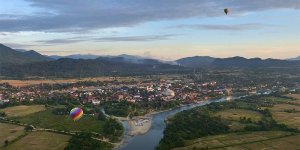| Published in Destinations |
Ávila, Spain
Ávila sits on the fertile Meseta Central plateau at an altitude of over 1100 m. It's near-freezing in winter and cool in summer, especially at the top end of town near the cathedral, catching the night breeze.
Get in
By plane
Madrid Barajas airport is 100 km south, with extensive connections domestically, across Europe, and to the Gulf States and Americas. Salamanca airport is only 50 km west but has few flights.
By car
From Madrid follow A6 north then AP51. From Segovia (70 km) follow N110 west to join AP51. From Salamanca (100 km) follow A50 south.
By buses
From Madrid run from Estación Sur de Autobuses ("South Station") off Calle de Méndez Álvaro, 1 km SE of Madrid Atocha railway station. They run every couple of hours, taking 80 mins, price €10. They're operated by Jimenez Dorado. Buses operated by La Sepulvedana also run from Ávila to Segovia (one hour) and Salamanca (2 hr 30). The main bus station is 500 m east of city centre, close to the railway station.
By trains
Fast trains run every hour or two from Madrid-Chamartin, via El Escorial, taking 90 mins. Most continue west to Salamanca, 70 mins. Ávila railway station is 500 m east of city centre.
Get around
Walking is usually best: try to avoid driving within the walled old town. A tourist 'train' also trundles round the main sights.
What to See in Ávila
• Muralla de Avila (Walls of Avila). Tues-Sun April-Oct 10:00-20:00, Nov-Mar 10:00-18:00. Remarkably complete, these were built between the 11th & 14th C and form a 2.5 km loop around the old town. You can of course see them free from the encircling road: anytime, but they're dramatic when floodlit at night. Note the blocks where Roman masonry has been recycled into the structure. There are two sections where you can walk on top of the wall, both covered by the same ticket. The E/NE section of 1440 m can be entered at three points: Casa de las Carnicerias on Calle San Segundo, Puente Adaja on Calle Marqués de Santo Domingo, and Arco del Carmen on Plaza Concepción Arenal by the Parador. The SE section of 260 m is entered at Puerta del Alcázar on Plaza Adolfo Suárez. 5€.
• Cathedral (Catedral de Cristo Salvador). M-F 10:00-20:00, Sa 10:00-21:00, Sun noon-19:30. Built mostly in the 11th & 12th C in Romanesque & Gothic style, and embedded in the eastern flank of the city walls. The exterior is a lumpy grey affair, but the Romanesque parts of the interior are a striking "blood limestone". 6€.
• Convento de Santa Teresa, Plaza de la Santa (S corner of walls). Tu-Sun 09:00-13:30 & 15:30-21:00. Convent and shrine built over the birthplace of St Teresa (1515-1582), who founded the Carmelitas Descalzadas, the "Barefoot Carmelites". Free.
• Iglesia de Santo Tome El Viejo: this 13th C church, just outside the city walls near the cathedral, is now a museum with Roman artefacts from in and around the city, including a large mosaic. Free entry.

Iglesia de Santo Tome El Viejo. ![]()
• Other notable churches are the Romanesque Basílica de San Vicente outside the NE corner of the walls, Iglesia de San Pedro 100 m east of the walls and Cathedral, and Convento de San José another 200 m east.
• Real Monasterio de Santo Tomas, Plaza de Granada 1 (1 km SE of centre, Bus 2 & Tourist Train run here). Daily 10:30-14:00 & 15:30-19:30. Mostly 15th C Dominican Convent, grouped around 3 cloisters. In 2018 it's being re-roofed, not a day too soon, so the first "Novice Cloister" is a closed-off building site. Also contains two small museums (same ticket): the oriental art and history of the Order's mission in China are interesting. The "natural history museum" is a dilapidated collection of dead beasts. 4€.

Real Monasterio de Santo Tomas. ![]()
What to Do in Ávila
Go horse-riding or take lessons at Centro Hipico Naturávila, 6 km east of town off Highway 505.
Restaurants
Usual meaty Castillian fare, the signature dish being the beef-steak Chuletón de Ávila. Yemas de Ávila (or Yemas de Santa Teresa) are a glootchy sweet made from egg yolks.
The main clusters of eating places are along Calle de San Segundo on the walls' east flank, and through the old town lanes into Plaza del Mercado Chico. You may struggle to find anything for dinner before 8.30 pm except tapas. But try El Portalon in Mercado Chico, or Gran Muralla Chinese Restaurant on C de San Segundo.
Bars and Clubs
At night Vallespin St. is the best choice for young travellers. During the day you can take tapas with beer (caña) in the square "el grande" behind the cathedral.
Hotels and Hostels
• Parador de Ávila, Calle Marques de Canales y Chozas 2 (From Av de Madrid follow C Ronda Vieja then Plaza Concepcion Arenal). 4-star parador in 16th C palace within the city walls. Free guest parking.
Tourist Info
The Tourist Information Centre is next to the Cathedral, open Thurs-Sun 10:30-14:00 & 15:30-19:30.
Go next
With your own car, visit the mountains of Gredos 50 km southwest, for hiking and wildlife. Historic villages here include Hoyos del Espino, Piedrahita, Barco de Ávila and Arevalo. You can also use the hill road south N403 to reach Toledo without going into Madrid. By public transport, the easy options are Salamanca, Segovia, El Escorial and Madrid. (Wikivoyage)
See also Ávila in Pictures.
YOU MAY ALSO LIKE






 If you own or manage a travel-related business such as a hotel, a bed-and-breakfast, a restaurant, a pub or a cafeteria, you can create a web page for your business for free on Titi Tudorancea Travel Info. » |



